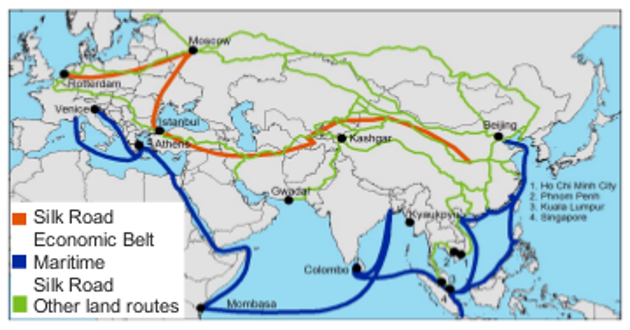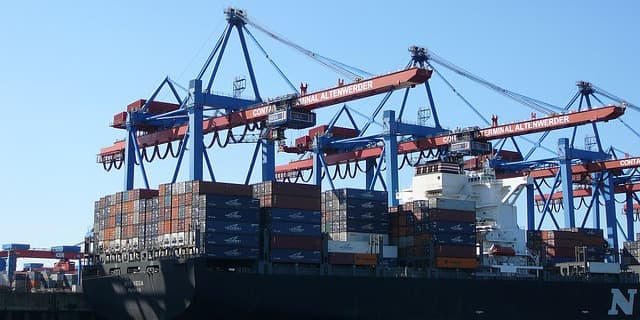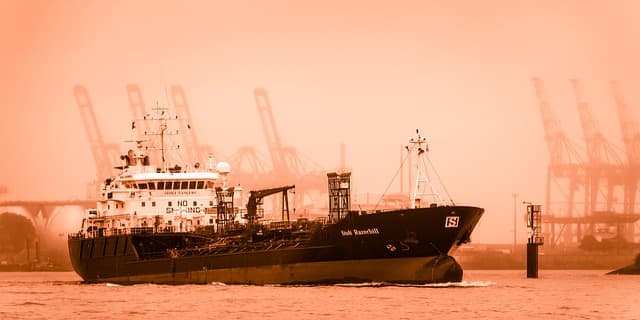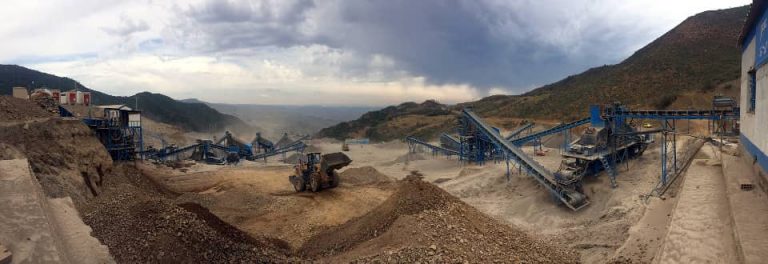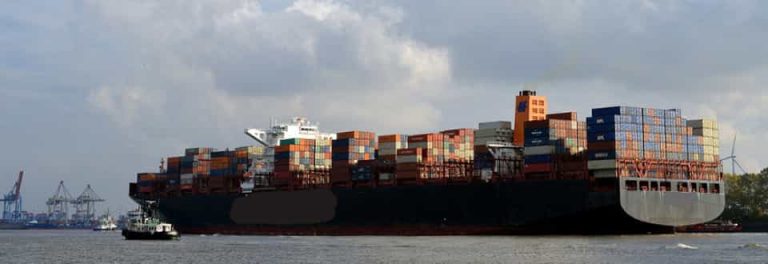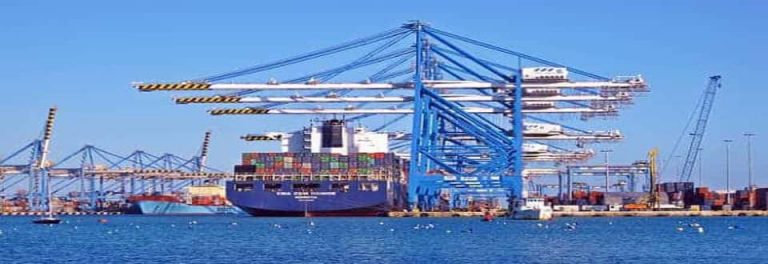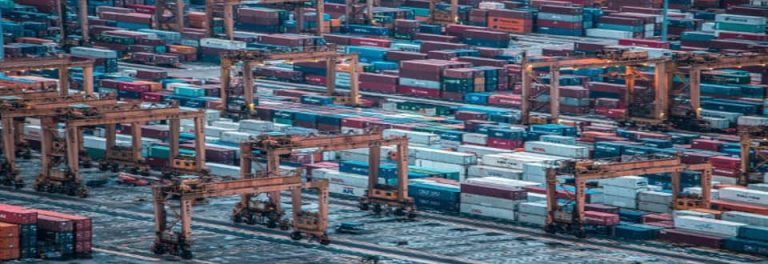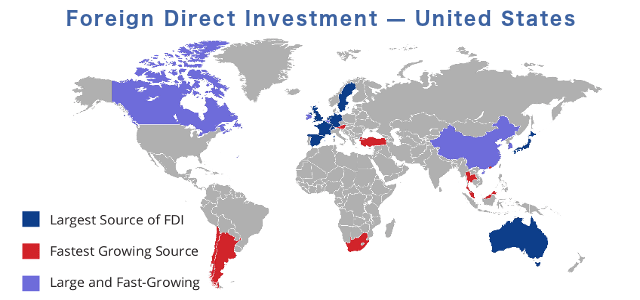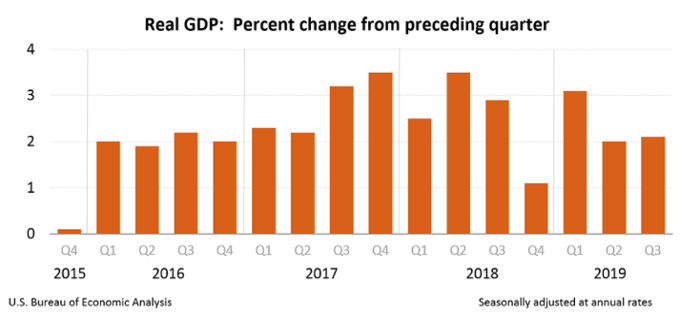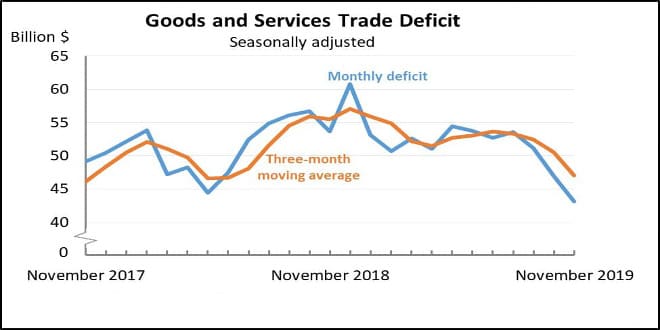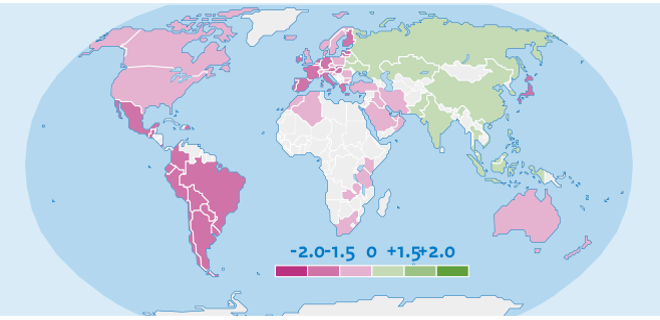An Interconnected & Interlinked World
of Business, Trade, and Commerce.
of Business, Trade, and Commerce.
Belt and Road Initiative—Objectives & Achievements
Informatization Along The Belt and Road Routes
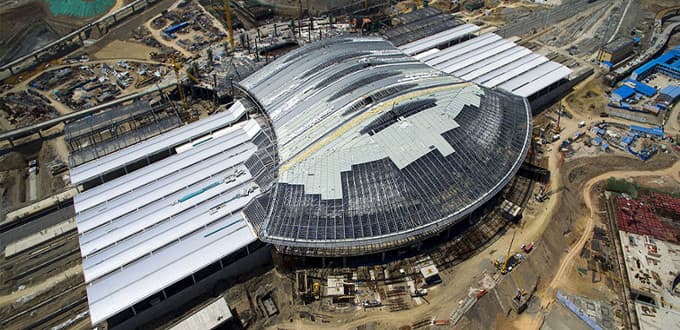
As of the end 2019, the Belt and Road Initiative (BRI)— a project conceived by China and put into motion in 2013 to interlink the global economies with that of Chinese economy, spans around 140 countries, including China, involving more than two thirds of the world’s population. The BRI amounts to 62% of the Caribbean, 67% of South America, 43% of Central America, 100% of the Middle East, 97% of Asia (excluding the Middle East), 59% of Oceania,73% of Africa, 58% of Europe.
The Objectives of The Belt & Road Initiative
China presented its Action plan on the Belt and Road Initiative in these words: the objective the Belt and Road initiative is “to construct a unified large market and make full use of both international and domestic markets, through cultural exchange and integration, to enhance mutual understanding and trust of member nations, ending up in an innovative pattern with capital inflows, talent pool, and technology database”.
The Belt and Road Initiative is a way for ‘win-win’ cooperation that promotes common development and prosperity and a road toward peace and friendship by enhancing mutual understanding and trust, and strengthening all-around exchanges.
It is a systematic project, which should be jointly built through consultation to meet the interests of all, and efforts should be made to integrate the development strategies of the countries along the Belt and Road.
The Initiative is open for cooperation. It covers, but is not limited to, the area of the ancient Silk Road. It is open to all countries, and international and regional organizations for engagement, so that the results of the concerted efforts will benefit wider areas.
The Initiative follows market operation. It will abide by market rules and international norms, give play to the decisive role of the market in resource allocation and the primary role of enterprises, and let the governments perform their due functions.
The Initiative seeks mutual benefit. It accommodates the interests and concerns of all parties involved, and seeks a conjunction of interests and the “biggest common denominator” for cooperation so as to give full play to the wisdom and creativity, strengths and potentials of all parties.
The initiative to jointly build the Belt and Road, embracing the trend toward a multipolar world, economic globalization, cultural diversity and greater IT application, is designed to uphold the global free trade regime and the open world economy in the spirit of open regional cooperation.
It is aimed at promoting orderly and free flow of economic factors, highly efficient allocation of resources and deep integration of markets; encouraging the countries along the Belt and Road to achieve economic policy coordination and carry out broader and more in-depth regional cooperation of higher standards; and jointly creating an open, inclusive and balanced regional economic cooperation architecture that benefits all.
The Belt and Road Initiative aims to promote the connectivity of Asian, European and African continents and their adjacent seas, establish and strengthen partnerships among the countries along the Belt and Road, set up all-dimensional, multitiered and composite connectivity networks, and realize diversified, independent, balanced and sustainable development in these countries.
The objective of the connectivity projects of the Initiative is to align and coordinate the development strategies of the countries along the Belt and Road, tap market potential in this region, promote investment and consumption, create demands and job opportunities, enhance people-to-people and cultural exchanges, and mutual learning among the peoples of the relevant countries, and enable them to understand, trust and respect each other and live in harmony, peace and prosperity.
The Scope and Achievements
BRI is a gargantuan economic project of enormous proportions — one that the history has never recorded before, that is moving forward at a super fast pace, already bearing the fruits for a very large number of countries along the Belt and Road Initiative, ushering in an era of economic cooperation and benefits of trade among the interconnected economies.
Utilizing its massive resources, enormous capacity, expertise – and the state supported financing, Chinese construction and manufacturing industry has gone into hyper drive building roads, railways, bridges, tunnels, ports, airports, communication systems, power generation stations, hospitals, schools, and other essential structures and facilities in the countries on and around the BIR countries—spurring economic growth for those economies, and opening new markets and opportunities for the Chinese businesses.
Belt and Road Initiative is paving the way for many countries which for centuries have been in desperate need to build and upgrade their transportation systems and infrastructure connectivity in order to vitalize their economies and uplift the standard of living for the masses. These countries are getting access to a much larger market for their goods and services, and, at the same time, having their infrastructure and industries revamped. It is indeed a ‘Win-Win’ deal for every one along the Belt and Road Initiative.
With a purely investment and business perspective the Belt & Road Initiative – along with the ‘MIC 2025’, is probably the greatest opportunity of the century.
As of the end of 2019, 140 countries are part of the project, according to data taken from Chinese sources.They include New Zealand, Russia, Italy, and even Syria.
China is undertaking what it considers the largest project of the century — linking itself with more than 100 countries across Asia, Africa, Europe, and Oceania through trade.
The Belt and Road Initiative is a massive trade and infrastructure project that aims to link China to dozens of economies across Asia, Europe, Africa, and Oceania.
The main focuses of the Belt and Road Initiative (BRI) — also known as “One Belt, One Road” — are in infrastructure, transportation — and energy.
Most BRI deals involve China lending vast amounts of money to other countries to build new railroads, shipping lanes, and other ventures in those countries. Investment from China alone in the project is estimated to be between $1 trillion and $8 trillion.
China’s Trade with BRI Countries Booms in 2019
As per the statistics presented at the BRI Portal; from 2013 to 2018, the trade volume between China and other countries along the Belt and Road surpassed 6 trillion dollars, and China’s investment in those countries exceeded 90 billion dollars.
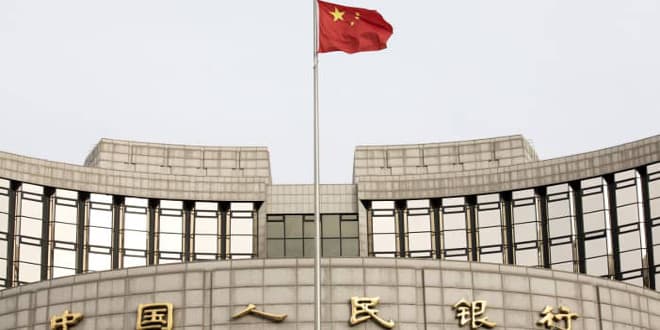
China’s trade with countries participating in the Belt and Road Initiative (BRI) posted robust growth in 2019, revealing the resilience of the world’s biggest trader against economic headwinds, customs data showed Tuesday.
Trade with BRI partner countries totaled 9.27 trillion yuan (about 1.34 trillion U.S. dollars) in 2019, up 10.8 percent year on year, outpacing the country’s aggregate trade growth by 7.4 percentage points, according to the General Administration of Customs (GAC).
In the 2014-2019 period, the total trade volume between China and BRI countries surpassed 44 trillion yuan, with an average annual growth of 6.1 percent. China has become the biggest trade partner of 25 BRI countries, GAC data showed.
BRI countries’ share of China’s total trade approached 30 percent last year, up by 2 percentage points from 2018.
Zou Zhiwu, vice minister of the GAC, noted that alongside fast growth with its major trading partners like the European Union and the Association of Southeast Asian Nations, China has also seen its imports and exports expand rapidly with the BRI countries and emerging economies in Africa and Latin America.
“The Chinese economy has significant resilience, potential and room to maneuver. It is the same in terms of its foreign trade,” said Zou, describing China’s trading partners as “globally scattered” and “flowering in various regions.”
Zou attributed the solid trade growth momentum with the BRI countries to enhanced customs cooperation and trade facilitation measures.
China has signed the most Authorized Economic Operator (AEO) agreements in the world to facilitate customs clearance for enterprises. Among all the 42 countries and regions holding AEO agreements with China, 18 are BRI countries and regions, he said.
The country has set up seven fast customs clearance channels for agricultural products at borders with BRI countries including Kazakhstan, Vietnam and Mongolia and promoted the opening of China-Europe freight trains for mail service.
Participating Economies and Their Share in The BRI
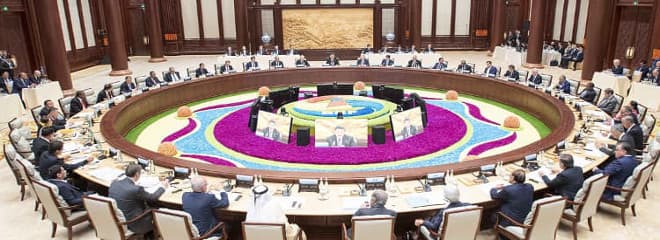
- China has concluded more than 200 intergovernmental cooperation agreements with 138 countries and 40 international organizations.
- The goods trade volume between China and countries and regions along the Belt and Road Initiatives has surpassed 6.8 trillion U.S. dollars from 2013 to 2019, according to the National Development and Reform Commission (NDRC).
China’s Foreign Direct Investment in countries along the BRI has reached more than 100 Billion U.S. dollars. - For the year 2019, China’s trade with B&R countries totaled about One Trillion U.S. dollars, and its non-financial direct investment in these countries topped 18 billion U.S. dollars.
- To provide for bilateral trade between the BRI participant economies and boost financial connectivity, China has signed currency swap agreements with 30 countries and formed RMB clearing arrangements with ten countries.
The Cross-border Interbank Payment System (CIPS) has covered more than 60 Belt and Road countries and regions. - The construction of the China-Laos railway, China-Thailand railway, Jakarta-Bandung High-Speed Railway and Hungary-Serbia railway are making solid headway while projects including the Gwadar Port, Hambantota Port, Piraeus Port and Khalifa Port are moving smoothly towards completion.
- China-Russia Crude Oil Pipeline, China-Central Asia Gas Pipeline, and China-Myanmar Oil & Gas Pipeline have been completed and are operational.
- The Eurasian (China-Europe) freight train service network—a crucial part of the Belt and Road Initiative that connects China with 56 cities in 16 European countries, has expanded rapidly, reaching 20,000 trips by the end of 2019, according to Landbrigde Logistics and National Bureau of Statistics of China. 99% of dispatched trains return with a comprehensive load rate of 88%.
- The building of the China-Belarus industrial park, China-UAE Industrial Capacity Cooperation Demonstration Zone and China-Egypt Suez Economic and Trade Cooperation Zone is also forging ahead with the objective of marketization and legalization mechanism to create tax sources and employment channels for these countries.
- On the China-Pakistan Economic Corridor—A showcase of the Belt and Road Initiative with nearly 20 Billion U.S. dollar investment already made, 19 main projects have been completed or are near completion.
Eight of the ten biggest power projects under Belt and Road Initiative are in Pakistan. Seven of these energy projects have gone into operation with a total installed capacity of 3.4 million kilowatts, which can meet the power need of 8.6 million households.
3 transportation projects were launched: Phase 2 of upgrading and renovation of Karakoram Highway, Karachi-Peshawar Motorway, and Lahore’s Orange Line are moving closer to completion.
The Belt and Road Initiative is an unprecedented opportunity for businesses and investors alike to hop into the Belt and Roads and participate in the fastest moving, developing, and booming ’economic conveyor belt’ in the world to reap enormous rewards.
元 $ € ¥ ₿
Information
Reports & Analysis
To Help Evaluate
The Potentials For
Business
&
Investment
In an Interconnected
World
-
The Belt and Road Initiative & Made in China 2025
Riding high on the fast tracks of the Belt and Road Initiative, Made in China 2025 is rapidly making inroads into the countries... Fierce competition from Chinese companies...
-
MIC 2025 || The Changing Landscape of Chinese Economy
It was in 2015 that China unveiled its Made in China 2025 (MIC 2015) project. Since then, Chinese economy is metamorphosing and changing at a breakneck pace...
-
Top Freight Forwarders by Country
Large scale ‘local area’ Freight Forwarders listed here, through their contacts and arrangements, also provide services on a global scale. Their main strength though lies in...
-
Most of the Top Global Freight Forwarders listed here serve all the major ports across the Globe, and, through relationships with their business partners, also provide a full suite of...
-
Glossary: Shipping, Freight, & Supply Chain Logistics
Like any other professional field, the shipping/freight industry has its own unique set of terminology—A rather extensive and complex one. Here we have compiled the Glossary of the most useful...
-
Global Foreign Direct Investment—Inward Flow
A comprehensive and historical Global FDI Inward-Flow Data spanning the period of 2000—2018. The data is compiled by grouping and associating a variety of economies together; by the state of...
-
The new phase of economy in China is an opportunity for the businesses. The emphasis is now on raising the living standards of masses, implementing supply-side reforms, and opening up...
-
Top 50 Container Ports in The World
Large Capacity & Super Busy Container Ports in a country are the pointers of country’s economic potentials...Bulk of the world trade in goods—more than 90% of it...
-
Supply Chain | Definition and Objectives
Supply Chain can be viewed as a network connecting a business to its suppliers and distributers to facilitate the production, processing, and distribution of its products to the consumers. It incorporates...
-
Global Business | Supply Chain & Logistics
With the technology—and global eCommerce platforms like Ali Baba, JD.com, Tancent, Kaola, Lazada, WooCommerce, VTEX, and Shopify etc, it is easier to sell products and services Globally.
-
Shipping Logistics | The Role of Service Providers
The logistics of getting the goods delivered to faraway destinations—especially to foreign markets, is a complex business. It requires the services of outside entities to...
-
Freight Forwarders | Role in Global Commerce
Freight Forwarders specialize in taking care of the entire process for their shippers | from warehousing to the shipping of their merchandise. They act as an agent and intermediary...
-
Real GDP | Nominal GDP vs GDP PPP
In evaluating and analyzing global investment opportunities and, also in the business decision making process, we need to know the actual comparative state of the economies of various countries and...
-
With the perspective of charting course for the expansion of business or investment, an analytical review of the ‘real value’ of a nation’s/region’s GDP is essential. To this end, an understanding of the methodologies used in...
-
New Global Business Order—The Global Information Stage
Whatever the business be, it has to be ready to play on the Global Stage. It is the global arena. The Supply-and-Demand chain is global. ..There is no business that can be considered as purely a...
-
Global Real GDP Growth Rate—And Forecast
Real GDP provides an inflation-adjusted measure that reflects the true value of all goods and services produced by an economy in term of real value of...
-
Foreign Direct Investment Inward Flow in The US—A Global Perspective
The Inflow of FDI in the U.S. was up by US $50 Billion in the 3rd quarter of 2019. FDI plays an essential role in the economic growth, creating jobs, and driving exports...The tables present...
-
US Gross Domestic Product: 2019—By Quarters
Real US GDP increased at an annualized rate of 2.1 percent in the 3rd quarter of 2019—that was up from the second quarter. Real gross domestic income (GDI)...
-
Foreign Direct Investment—Impact and Analysis
Foreign Direct Investment (FDI) plays an important role in the development and growth of any country’s economy - especially the developing countries. But, in actual practice...
-
Foreign Direct Investment and Business in China
China is establishing itself as the Model Destination for FDI inflow and a hub for corporate relocation and R&D...
-
US Global Trade & Top Trading Partners | Year-to-Date
Since hitting the peak in November 2018, U.S. global trade deficit in goods and services has been on the decline. But, the declining trends in both Imports and exports...
-
The Growth of Mobile Payments and Virtual Banking—A Global Perspective
Mobile Payments, Virtual Banking, and other modes of mobile transactions - both at consumer and commercial level, are growing globally at an ultra fast pace — more so in China and Asia Pacific and...
-
Belt and Road Initiative—Objectives & Achievements
As of the end 2019, the BRI — a project to interlink the global economies with China, includes 140 countries—encompasing more than 2/3 of the world’s population. The trade on BRI is...
-
In 2019 US imports from China dropped more than 12.5 percent to US$456 billion (Source: United States’ Census Bureau ) while China’s imports from the US dropped to US$122.7 billion...
-
Humans by nature - or by need, are traders. We trade our work, services, produce, or products for money. Then, we exchange that money for the goods and services that we need. Any excess/leftover money is either directly invested or deposited in the banks—thus, making the money to recirculate in the economy again.
Information, Data, and Reports organized alphabetically By Topic:
Global Business
Investment
Trade & Commerce
Always The Key to
to Wealth & Prosperity
Since before the days of
Camel Caravans & Sailboats


